Timeline of the presidency of Gerald Ford
| Presidency of Gerald Ford | |
|---|---|
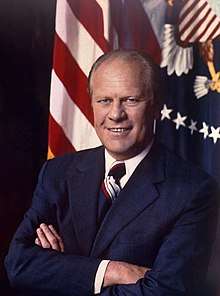 | |
| In office | |
| August 9, 1974 – January 20, 1977 | |
| Preceded by | Nixon presidency |
| Succeeded by | Carter presidency |
| Seat | White House, Washington, D.C. |
| Political party | Republican |
The presidency of Gerald Ford began on August 9, 1974, when Gerald Ford became President of the United States, and ended on January 20, 1977, a span of 895 days. Ford, the 38th United States president, succeeded Richard Nixon, who had resigned from office. Prior to this he was the 40th Vice President of the United States, serving from 1973 until President Richard Nixon's resignation in 1974. He was the first person appointed to the vice presidency under the terms of the Twenty-fifth Amendment to the United States Constitution, following the resignation of Vice President Spiro Agnew on October 10, 1973. Ford has the distinction of being the first, and to date the only person to have served as both vice president and president without being elected to either office.
As President, Ford signed the Helsinki Accords, marking a move toward détente in the Cold War. With the conquest of South Vietnam by North Vietnam nine months into his presidency, U.S. involvement in Vietnam essentially ended. He made seven international trips while in office. Domestically, Ford presided over the worst economy in the four decades since the Great Depression, with growing inflation and a recession during his tenure.[1] One of his more controversial acts was to grant a presidential pardon to President Richard Nixon for his role in the Watergate scandal. He also faced two assassination attempts. Ford's presidency, foreign policy was characterized in procedural terms by the increased role Congress began to play, and by the corresponding curb on the powers of the President.[2]
Ford ran unsuccessfully for a full four-year presidential term in 1976. In the 1976 Republican presidential primary campaign he defeated challenger Ronald Reagan to win the Republican nomination in that year's Republican presidential primaries to win the Republican nomination, but narrowly lost the presidential election to his Democratic opponent, Jimmy Carter.
1974
August – September

- August 9 – Gerald Ford takes the oath of office as president, administered by Chief Justice Warren Burger, in the East Room of the White House. Immediately afterward, he speaks to the assembled audience in a speech broadcast live to the nation.[3] Ford notes the peculiarity of his position, saying "I am acutely aware that you have not elected me as your president by your ballots, and so I ask you to confirm me as your president with your prayers."[4] He also declares, "My fellow Americans, our long national nightmare is over. Our Constitution works; our great Republic is a government of laws and not of men. Here, the people rule. But there is a higher Power, by whatever name we honor Him, who ordains not only righteousness but love, not only justice, but mercy. ... let us restore the golden rule to our political process, and let brotherly love purge our hearts of suspicion and hate."[5] This remains the most recent non-scheduled presidential inauguration in American history.
- August 9 – Following the swearing-in ceremony, President Ford meets with Congressional leaders, senior White House staff, transition advisers, senior economic advisers, and foreign emissaries.
- August 9 – Jerald terHorst is appointed to serve as President Ford's White House Press Secretary.
- August 12 – President Ford addresses a Joint session of the United States Congress. He states, "I do not want a honeymoon with you. I want a good marriage." He also states his first priority is to bring inflation under control, declaring it "public enemy number one."
- August 15–18 – President Ford hosts King Hussein of Jordan. He is the first foreign head of state to be received by President Ford.[6]
- August 19 – President Ford delivers a major speech to the Veterans of Foreign Wars convention in Chicago, supporting earned clemency for Vietnam War draft evaders.
- August 19 – Rodger Davies, the United States Ambassador to Cyprus, along with Antoinette Varnavas, an embassy secretary, and a Greek Cypriot national are killed by sniper fire during an anti-American demonstration outside the U.S. Embassy in Nicosia,[7] protesting against the failure of the U.S. to stop the Turkish invasion of Cyprus.[8] Afterwards, the U.S. government quickly sends his replacement, Ambassador to Yemen William R. Crawford, in order to demonstrate that "it was not blaming Greek-Cypriot authorities for the murder".[9]
- August 20 – President Ford nominates Nelson Rockefeller, former Governor of New York, to be vice president.
- August 22 – President Ford signs the Housing and Community Development Act of 1974.
- August 28 – President Ford holds his first press conference as President. Many of the questions concern unresolved issues surrounding Watergate.
- September 8 – President Ford issues a proclamation which grants former president Nixon a full and unconditional pardon for any crimes he might have committed against the United States while President.[10] The surprise announcement stuns the country and Ford's approval rating plummets in the polls. Press Secretary Jerald terHorst resigns in protest after the pardon. Full text

- September 16 – President Ford issues a proclamation announcing an amnesty program for Vietnam Era draft evaders and military deserters who return home. The conditions of the amnesty required the individual to reaffirm their allegiance to the United States and serve two years working in a public service job or a total of two years' service for those who had served less than two years of honorable service in the military.[11][12] A Clemency Board was established to review personnel records and to make recommendations for receiving a Presidential Pardon and a change in Military discharge status.
- September 26–28 – First Lady Betty Ford is diagnosed with breast cancer and undergoes surgery.
- September 27–28 – The White House convenes a "summit conference" on inflation and the economy. President Ford closes the conference with an address to the American people, asking them to send him a list of ten inflation-reducing ideas.[13]
October – December
- October 8 – Ford announces his Whip Inflation Now program before a joint session of Congress.
- October 11 – Ford signs the Energy Reorganization Act of 1974 establishing the Nuclear Regulatory Commission.
- October 15 – Ford signs the Federal Election Campaign Act Amendments of 1974, which seek to regulate campaign fundraising and spending.
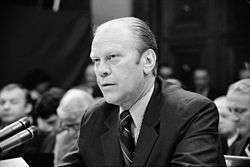
- October 17 – Ford appears before the House Judiciary Subcommittee on Criminal Justice to explain the facts and circumstances that were the basis for his pardon of former President Richard Nixon. He is the first sitting President since Abraham Lincoln to testify before the House of Representatives .[14][15]
- October 17 – Ford vetoes the Freedom of Information Act Amendments believing not enough protection is given to sensitive and classified intelligence documents. Congress overrides Ford's veto on November 21, 1974 making the bill law.
- October 21 – Ford makes the first international trip of his presidency, travelling to Nogales and Magdalena de Kino, Mexico. There he meets with President Luis Echeverría and lay a wreath at the tomb of Padre Eusebio Kino.[16]
- November 1 – Ford meets with an ailing Richard Nixon in a Long Beach, California hospital.
- November 5 – Republicans lose 40 seats in the House and 4 in the Senate, widening the Democratic majority in Congress during the 1974 midterm elections.

- November 19–24 – Ford makes the second international trip of his presidency:[16]
- November 19–22 – State visit to Tokyo and Kyoto; meets with Prime Minister Kakuei Tanaka. This is the first visit to that country by an incumbent American President
- November 22–23 – Travels to Seoul, South Korea; meets with President Park Chung-hee.
- November 23–24 – Travels to Vladivostok, Soviet Union; meets with General Secretary Leonid Brezhnev. The two heads of state agree to terms that would limit both nations an "equal aggregate number" of various weapons, including strategic nuclear delivery vehicles (SNDVs), intercontinental ballistic missiles (ICBMs), and submarine-launched ballistic missiles (SLBMs) fitted with multiple independently targetable reentry vehicles (MIRVs).[17]
- December 14–16 – Ford makes the third international trip of his presidency, travelling to Fort-de-France, Martinique, for a meeting with French President Valéry Giscard d'Estaing.[16]
- December 17 – Ford lights the National Community Christmas Tree, a living 42-foot Colorado blue spruce, decorated with over 2,000 tiny amber and white energy conserving lights, as well as braided gold-colored rope and large gold ornaments.[18] Later, in his first Christmas greeting to the American people as president, Ford mentions that as a former National Park Service ranger and as someone concerned with environmental conservation, he was very pleased by the fact that his first National Christmas tree was a living one.[19]
- December 19 – The President delivers remarks at the American Freedom Train dedication ceremonies at Alexandria Union Station in Alexandria, Virginia.[20]
- December 19 – Following Congressional approval, Nelson Rockefeller is sworn in as the 41st Vice President of the United States.
1975
January – February
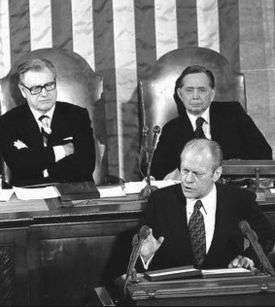
- January 1 – Ford signs the Privacy Act of 1974.
- January 4 – Ford signs the Federal-Aid Highway Amendments of 1974.[21] Among other changes, the law permanently implements a national 55-mph speed limit (which had already been a temporary limit) for the Interstate Highway System.
- January 4 – Ford names a Blue Ribbon panel, chaired by Vice President Rockefeller, to review CIA Activities within the United States in response to allegations made in a December New York Times article by Seymour Hersh.
- January 13 – Ford delivers a "fireside chat" to the nation, outlining his proposals to fight inflation, the economic recession, and energy dependence.
- January 15 – In his first State of the Union Address, Ford announces bluntly that "the state of the Union is not good. Millions of Americans are out of work. Recession and inflation are eroding the money of millions more. Prices are too high, and sales are too slow." To remedy these problems, Ford proposes tax cuts for American families and businesses, and strongly advocates for the reduction of government spending.
- February 7 – Edward H. Levi is sworn in as the new Attorney General of the United States replacing William B. Saxbe, whom Ford appoints as U.S. Ambassador to India.
March – April
- March 10 – Carla Hills becomes United States Secretary of Housing and Urban Development, the first woman to serve in this position.[22]
- March 29 – Ford signs the Tax Reduction Act of 1975.
- April 3 – President Ford announces Operation Babylift, which would evacuate about 2,000 orphans from south Vietnam.
- April 8 – President Ford signs Executive Order 11850, a renunciation of certain uses in war of chemical herbicides and riot control agents.[23] The executive order restricts the use of herbicides, and riot control agents, including tear gas. Each and every use would require explicit approval.
- April 10 – As divisions of the North Vietnamese Army approach Saigon; Ford addresses a joint session of Congress to request, unsuccessfully, financial assistance for South Vietnam and Cambodia. (Vietnam Humanitarian Assistance and Evacuation Act of 1975) During the speech two freshman Democrats, Toby Moffett of Connecticut and George Miller of California walk out in protest.
- April 12 – Ford orders the evacuation of U.S. personnel (military and civilian) and allied Cambodians from Cambodia as the Khmer Rouge advance on the capital Phnom Penh. The Khmer Rouge take over the country on April 17, 1975.
- April 23 – In a speech at Tulane University, President Ford declares that the Vietnam War "is finished as far as America is concerned."

- April 28 – With the fall of Saigon to the North Vietnamese Army immanent, President Ford orders the emergency evacuation of all remaining American military personnel and civilians and at-risk South Vietnamese nationals from the city.
- April 29–30 – Operation Frequent Wind, the final phase in the American evacuation from South Vietnam, is carried out. More than 1,400 U.S. citizens and 5,500 third country nationals and South Vietnamese are evacuated by helicopter from landing zones in and around the United States Embassy and Tân Sơn Nhứt Airport in Saigon. It is the largest helicopter evacuation in history.[24] By the afternoon of April 30, North Vietnamese troops are in control of the important points of the city (subsequently renamed Hồ Chí Minh City) and have raised their flag over the South Vietnamese presidential palace.
May – June
- May 12–15 – When Cambodia seizes the American container ship SS Mayaguez in international waters, Ford orders U.S. Marines to rescue the ship's crew. The civilians are safely recovered and a long hostage crisis averted, but many Marines die. This was the last official battle of the Vietnam War. The names of the Americans killed, as well as those of three Marines who were left behind on the island of Koh Tang after the battle and were subsequently executed by the Khmer Rouge, are the last names on the Vietnam Veterans Memorial.[25]
- May 23 – Ford signs the Indochina Migration and Refugee Assistance Act, allowing refugees from South Vietnam, Laos and Cambodia to enter the United States under a special status.[26]
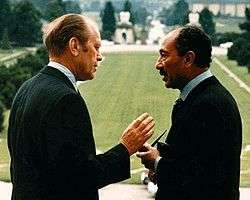

- May 28 – June 3 – Ford makes the fourth international trip of his presidency:[16]
- May 28–31 – Travels to Brussels, Belgium; attends the NATO Summit Meeting, addresses the North Atlantic Council and meets separately with NATO heads of state and government.
- May 31 – June 1 – Travels to Madrid, Spain; meets with Generalissimo Francisco Franco, and receives the keys to the city of Madrid from mayor Miguel Angel García-Lomas Mata.
- June 1–3 – Travels to Salzburg, Austria; meets with Chancellor Bruno Kreisky and Egyptian President Anwar Sadat.
- June 3 – Travels to Rome, Italy; meets with President Giovanni Leone and Prime Minister Aldo Moro.
- June 3 – Visits the Apostolic Palace, Vatican City; has an audience with Pope Paul VI.
July – August
- July 8 – Ford formally announces his candidacy for the 1976 Republican presidential nomination.
- July 15 – Apollo and Soyuz spacecraft launch within seven-and-a-half hours of each other, and dock together two days later. Known as the Apollo–Soyuz Test Project, it is the first joint U.S.–Soviet space flight. It would also be the last manned U.S. space mission until the first Space Shuttle flight in April 1981.
- July 26 – August 4, 1975 – Ford makes the fifth international trip of his presidency:[16]
- July 26–28 – Travels to Bonn and Linz am Rhein, West Germany; meets with President Walter Scheel and Chancellor Helmut Schmidt.
- July 28–29 – Travels to Warsaw and Kraków; meets with First Secretary Edward Gierek.
- July 29 – August 2 – Travels to Helsinki, Finland; attends opening session of the Conference on Security and Cooperation in Europe. Ford meets with Soviet General Secretary Brezhnev, and joins leaders of 34 nations in signing the Final Act of the Conference.
- August 2–3 – Travels to Bucharest and Sinaia, Romania; meets with President Nicolae Ceaușescu.
- August 3–4 – Travels to Belgrade, Yugoslavia; meets with President Josip Broz Tito and Prime Minister Džemal Bijedić.
September – October
- September 1 – Ford announces a joint Egyptian-Israeli agreement on troop disengagement in the Sinai Peninsula. The agreement, signed in Geneva on September 4, 1975, is the culmination of 34 days of shuttle diplomacy by Secretary of State Henry Kissinger.
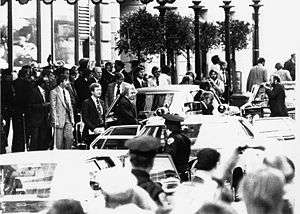
- September 5 – Lynette "Squeaky" Fromme, a follower of Charles Manson, attempts to assassinate President Ford in Sacramento, California.[27] She is later convicted of attempted assassination of the President and sentenced to life in prison. (She was paroled on August 14, 2009.)[28]
- September 22 – Sara Jane Moore, a Patty Hearst fanatic,[29] with ties to leftwing radical groups, attempts to assassinate President Ford as he left the St. Francis Hotel in downtown San Francisco, California. She is later convicted of attempted assassination of the President and sentenced to life in prison. (She was paroled on December 31, 2007.)[30]
- October 2–3 – Ford hosts Japanese Emperor Hirohito and Empress Nagako for a state visit. This is the first state visit for an Emperor and Empress of Japan to the United States.
- October 29 – Ford urges financial restraint and a financial review for New York City during its fiscal crisis. Ford refuses to support Federal help for New York at this time. He proposes bankruptcy legislation to ensure the City undergoes an orderly default process.
November – December
- November 4 – In what the press dubs the Halloween Massacre, President Ford undertakes a reorganization of his Cabinet. The changes are:
- Henry Kissinger is fired as National Security Advisor (but retains his post as Secretary of State), and replaced by General Brent Scowcroft;
- William Colby is fired as Director of Central Intelligence and replaced by George H. W. Bush;
- James Schlesinger is fired as Secretary of Defense and replaced by Chief of Staff Donald Rumsfeld;
- Rumsfeld's deputy and protégé, Dick Cheney, moves up to be the Chief of Staff;
- Additionally, under pressure from Republican Party Conservatives, Vice President Nelson Rockefeller withdraws his name from consideration as Ford's 1976 running mate.
- November 15–17 – Ford makes the sixth international trip of his presidency, travelling to Rambouillet, France, for the 1st G6 summit with President Valery Giscard d'Estaing of France, Chancellor Helmut Schmidt of West Germany, Prime Minister Aldo Moro of Italy, Prime Minister Takeo Miki of Japan, and Prime Minister Harold Wilson of the United Kingdom.[16]
- November 20 – Former California Governor Ronald Reagan announces that he will challenge Gerald Ford for the 1976 Republican presidential nomination.
- November 26 – After he believes New York City leaders have begun to adequately address the city's financial crisis, Ford authorizes Congress to extend the city a line of credit.
- November 28 – Ford nominates Judge John Paul Stevens of the Seventh Circuit of the Court of Appeals to replace Associate Justice William O. Douglas. Stevens was confirmed by the United States Senate in a 98-0 vote on December 17, 1975, and sworn in two days later.[31][32]
- November 30 – Ford signs the Education for All Handicapped Children Act of 1975, which established special education throughout the United States.
- December 1–7 - Ford makes the seventh international trip of his presidency:[16]
- December 1–5 – Travels to Beijing, China; meets with Communist Party Chairman Mao Zedong and Vice Premier Deng Xiaoping to build momentum toward normalization of relations.
- December 5–6 – Travels to Jakarta, Indonesia; meets with President Suharto.
- December 6–7 – Travels to Manila, Philippines; meets with President Ferdinand Marcos.
- December 19 – Ford opposes the Tunney Amendments of the Defense Appropriations Bill but the Senate passes them 54-22. The amendments prohibit funding for U.S. activities aimed at defeating the Soviet and Cuban backed MPLA factions in the Angolan Civil War.
- December 22 – Ford signs the Energy Policy and Conservation Act, creating a comprehensive approach to federal energy policy in response to the 1973 oil crisis.
1976
January – February
- January 2 – Facing stiff opposition from a surging Ronald Reagan in the run-up to the 1976 Republican primaries and a more assertive Republican right wing, Ford vetoes the Common Situs Picketing Bill, which would have amended National Labor Relations Act rules regarding union recognition, organizing and the rights to picket.
- January 31 – John Dunlop resigns as Secretary of Labor and is replaced by William Usery Jr..
- February 6 – Ford signs Executive Order 11904 establishing the Defense Superior Service Medal, to be awarded to members of the United States Armed Forces (most often presented to senior officers in the flag and general officer grades, followed by a lesser number of Colonels and USN and USCG Captains) who perform "superior meritorious service in a position of significant responsibility".[33]
- February 18 – In an effort to reform the United States Intelligence Community, Ford signs Executive Order 11905 to "establish policies to improve the quality of intelligence needed for national security, to clarify the authority and responsibilities of the intelligence departments and agencies, and to establish effective oversight to assure compliance with law in the management and direction of intelligence agencies and departments of the national government." This executive order also prohibits the United States from engaging in political assassination.
- February 26 – Gerald Ford edges Ronald Reagan by 1,250 votes in the New Hampshire primary, taking 17 of 21 delegates. This begins a string of primary victories for Ford which include Florida and Illinois before a series of losses to challenger Reagan in North Carolina, Texas, Georgia, Alabama, and Indiana.
March – April
- March 25 – Ford sends a message to Congress requesting a special appropriation for the National Swine Flu Immunization Program, in order to immunize 200 million-plus people against a feared swine flu outbreak. He signs the measure into law on August 12, 1976.
May – June
- May 15 – Ford becomes the first President since Harry Truman to campaign by train as he crosses southern Michigan prior to that state's presidential primary.
- June 11 – Ford signs Executive Order 11921 adjusting emergency preparedness assignments amongst Federal departments and agencies.

- June 16 – Francis E. Meloy, Jr., the incoming U.S. Ambassador to Lebanon, along with Robert Waring, the U.S. Economic Counselor, and their driver, Zuhair Mohammed Moghrabi, are kidnapped by Popular Front for the Liberation of Palestine members as they cross the Green Line, the division between Beirut's Christian and Muslim sectors. The bullet-riddled bodies of Meloy and Waring are found later that day on a beach in Ramlet al-Baida.[34]
- June 17 – The president meets with CIA Director George H.W. Bush, Chief of Staff Dick Cheney and Special Emissary to Lebanon L. Dean Brown, and others, during a meeting of the National Security Council to discuss the evacuation of Americans from Beirut, the capital of Lebanon. The following day, an initial group of approximately 200 American and Lebanese Nationals are evacuated.
- June 20 – The President orders the evacuation of American citizens from Lebanon.[35] That day, 110 Americans and 157 nationals of other countries are transported from Lebanon to Piraeus, Greece aboard USS Spiegel Grove.[36] Approximately 300 additional persons, including around 150 Americans, are evacuated on July 27, aboard USS Coronado, and also taken to Piraeus Greece.[37]
July – August
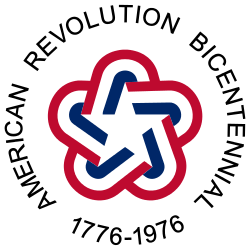
- July 4 – America's Bicentennial of independence. The year is marked by numerous head of state visits and state gifts to the United States. On July 4, President Ford attends events at Valley Forge National Historical Park, Pennsylvania; Operation Sail in New York City; and in Philadelphia, Pennsylvania.
- July 7 – President and Mrs. Ford welcome Queen Elizabeth II of the United Kingdom and Prince Philip, Duke of Edinburgh to the White House for a state dinner as part of the Bicentennial celebration.
- August 18 – When North Korean soldiers axe-murder two U.S. soldiers on a tree-pruning mission in the Korean Demilitarized Zone, the President and his advisors consider a strong military response, but decide on other measures to chasten North Korea, but without causing further escalation.[38]
- August 19 – Gerald Ford is nominated for a full term as president at the Republican Convention, held in Kemper Arena in Kansas City, Missouri, edging out former California Governor Ronald Reagan. United States Senator Robert Dole of Kansas is nominated for Vice President.
September – October
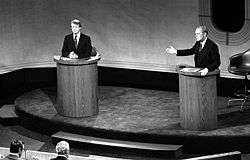
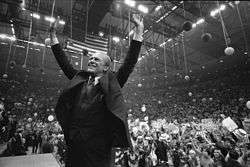
- September 13 – Ford signs the Government in the Sunshine Act requiring that many government regulatory agencies must give advance notice of meetings and hold open meetings. The new law also amends the Freedom of Information Act "by narrowing the authority of agencies to withhold information from the public."
- September 15 – Ford kicks off his general election campaign at the University of Michigan in Ann Arbor, Michigan.
- September 23 – First presidential candidate debate between President Ford and Governor Jimmy Carter, domestic policy, at the Walnut Street Theatre in Philadelphia. This is the first presidential candidate debate since the Nixon-Kennedy debates in 1960.
- September 30 – The Hart–Scott–Rodino Antitrust Improvements Act, a set of amendments to the antitrust laws of the United States, principally the Clayton Antitrust Act, is signed into law by President Ford.
- October 6 – Second presidential candidate debate, on foreign policy and defense issues, in San Francisco. During the debate Ford comments that, "there is no Soviet domination of Eastern Europe and there never will be under a Ford administration." This misstatement is fodder for the press and public for the next several days.
- October 14 – President Ford receives a swine flu inoculation from his White House physician, Dr. William Lukash.
- October 21 – The president signs the Resource Conservation and Recovery Act.
- October 22 – Third and final presidential candidate debate in Williamsburg, Virginia.
November – December
- November 1 – President Ford attends his final campaign rally in Grand Rapids, Michigan at the Pantlind Hotel.
- November 2 – President Ford casts his vote and attends the unveiling of the Gerald R. Ford mural by artist Paul Collins at the Kent County Airport before returning to Washington.
- November 3 – President Ford concedes the Presidential election to Jimmy Carter of Georgia. Ford loses the Electoral College 297–240 and receives 39,147,793 votes (48% of the votes cast) to Carter's 40,830,763 (50.1% of the votes cast).
- November 22 – President Ford meets with President-elect Carter in the Oval Office to discuss the transition of presidential power.
- December 14 – President Ford sends a letter to the Archivist of the United States and the President of the University of Michigan offering to deposit his papers in a Presidential Library to be built on the University of Michigan campus.
1977
January
- January 12 – In his final State of the Union Address, Ford tells Congress and the American People, "I can report that the state of the union is good. There is room for improvement, as always, but today we have a more perfect Union than when my stewardship began."
- January 19 – Ford signs Executive Order 11965 establishing the Humanitarian Service Medal, to be awarded to members of the Armed Forces of the United States who, after April 1, 1975, distinguished themselves by meritorious direct participation in a United States Department of Defense approved significant military act or operation of a humanitarian nature.[39]
- January 20 – Jimmy Carter is inaugurated as the 39th President of the United States. In his inaugural address, Carter states, "For myself and for our Nation, I want to thank my predecessor for all he has done to heal our land."
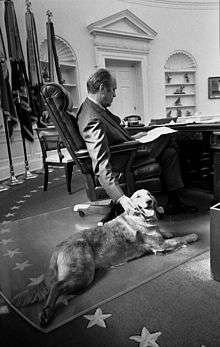
References
- ↑ Frum, David (2000). How We Got Here: The '70s. New York, New York: Basic Books. pp. xxiii, 301. ISBN 0-465-04195-7.
- ↑ George Lenczowski (1990). American Presidents, and the Middle East. Duke University Press. pp. 142–143. ISBN 0-8223-0972-6.
- ↑ "Gerald R. Ford's Remarks Upon Taking the Oath of Office as President". The Gerald R. Ford Presidential Library. August 9, 1974. Retrieved November 18, 2010.
- ↑ "Remarks By President Gerald Ford On Taking the Oath Of Office As President". Watergate.info. 1974. Archived from the original on July 3, 2008. Retrieved December 28, 2006.
- ↑ Ford, Gerald R. (August 9, 1974). "Gerald R. Ford's Remarks on Taking the Oath of Office as President". Gerald R. Ford Presidential Library. Archived from the original on August 13, 2012. Retrieved May 2, 2011.
- ↑ "Visits By Foreign Leaders in 1974". Washington, D.C.: U.S. Department of State Office of the Historian. Retrieved August 21, 2016.
- ↑ "U.S. ambassador killed on Cyprus". Boca Raton News. Nicosia. 19 August 1974.
- ↑ Nick Carbone (September 12, 2012). "Before Libya: U.S. Ambassadors Who Have Died in the Line of Duty". Time.
- ↑ "Cyprus: Looking for Paradise Lost". Time. September 2, 1974.
- ↑ "Ford Pardons Nixon - Events of 1974 - Year in Review". UPI.com. Retrieved November 4, 2011.
- ↑ Hunter, Marjorie (September 16, 1974). "Ford Offers Amnesty Program Requiring 2 Years Public Work; Defends His Pardon Of Nixon". The New York Times. Retrieved August 10, 2013.
- ↑ "Gerald R. Ford: Proclamation 4313 - Announcing a Program for the Return of Vietnam Era Draft Evaders and Military Deserters". ucsb.edu.
- ↑ "WIN is losing". Washington Post. Dec 20, 1974. Retrieved August 26, 2016.
- ↑ "Ford Testimony on Nixon Pardon - C-SPAN Video Library". C-spanvideo.org. October 17, 1974. Retrieved December 30, 2012.
- ↑ "Sitting presidents and vice presidents who have testified before congressional committees" (PDF). Senate.gov. 2004. Retrieved November 22, 2015.
- 1 2 3 4 5 6 7 "Travels of President Gerald R. Ford". U.S. Department of State Office of the Historian.
- ↑ "Arms Control Summits". PSR.org. Physicians for Social Responsibility. Retrieved 25 January 2013.
- ↑ Rippeteau, Jane (December 18, 1974). "President Lights the National Christmas Tree". The Washington Post.
- ↑ "White House Christmas Cards & Messages of the Presidents of the United States: Christmas Cards & Messages from Gerald Ford (1974-1977)". Retrieved August 19, 2016.
- ↑ "Gerald R. Ford: Remarks at American Freedom Train Ceremonies in Alexandria, Virginia". The American Presidency Project. December 19, 1974. Retrieved August 29, 2016.
- ↑ "A Chronology of Dates Significant in the Background, History and Development of the Department of Transportation". U.S. Department of Transportation. October 3, 2008. Archived from the original on February 15, 2008. Retrieved 2009-03-09.
- ↑ Uchitelle, Louis (June 10, 1990). "A Crowbar for Carla Hills". New York Times. Retrieved August 22, 2016.
- ↑ "Executive Order 11850--Renunciation of certain uses in war of chemical herbicides and riot control agents". National Archives. April 8, 1975. Retrieved May 17, 2016.
- ↑ Dunham, George R.; Quinlan, David A. (1990). U.S. Marines in Vietnam: The Bitter End, 1973–1975. History and Museums Division, Headquarters, U.S. Marine Corps. p. 202.
- ↑ Wetterhahn, Ralph (2002). The Last Battle: The Mayaguez Incident and the end of the Vietnam War. Plume. ISBN 0-452-28333-7.
- ↑ Haines, David (1996). Refugees in America in the 1990s: a reference handbook. New York: Greenwood Press.
- ↑ "1975 Year in Review: Ford Assassinations Attempts". Upi.com. Retrieved May 30, 2011.
- ↑ "Charles Manson follower Lynette 'Squeaky' Fromme released from prison after more than 30 years". Daily News. New York. Associated Press. August 14, 2009. Retrieved September 7, 2011.
- ↑ "Timeline: Guerrilla: The Taking of Patty Hearst". American Experience. Public Broadcasting Service. 2005-02-16. Retrieved 2007-01-03.
- ↑ Lee, Vic (January 2, 2007). "Interview: Woman Who Tried To Assassinate Ford". San Francisco: KGO-TV. Retrieved January 3, 2007.
- ↑ Federal Judicial Center page on John Paul Stevens Archived 2009-01-18 at the Wayback Machine..
- ↑ U.S. Senate Roll Call Votes - Nomination of John Paul Stevens, senate.gov
- ↑ "Gerald R. Ford: Executive Order 11904 - Establishing the Defense Superior Service Medal". The American Presidency Project. February 6, 1976. Retrieved August 23, 2016.
- ↑ Robert Fisk (2001). Pity the Nation: Lebanon at War. Oxford University Press. p. 83.
- ↑ "CBS Evening News for Sunday, Jun 20, 1976". Retrieved 26 October 2012.
- ↑ "Evacuees aboard ship in party mood". The Miami News. 21 June 1976. Retrieved 30 October 2012.
- ↑ "Marines Backed Beirut Rescue". Chicago Tribune. July 30, 1976. p. 10. Retrieved 30 October 2012.
- ↑ Gawthorpe, A. J. (2009), "The Ford Administration and Security Policy in the Asia-Pacific after the Fall of Saigon", The Historical Journal, 52(3):697–716.
- ↑ "Gerald R. Ford: Executive Order 11965 - Establishing the Humanitarian Service Medal". The American Presidency Project. January 19, 1977. Retrieved August 23, 2016.
![]()
